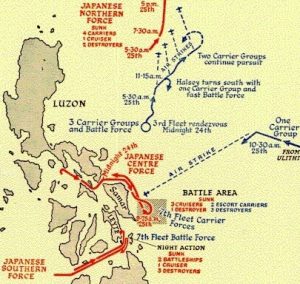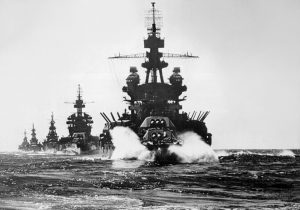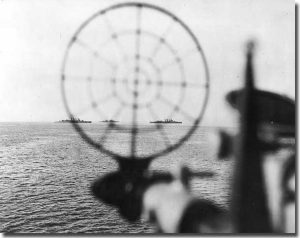- Author
- Kingsley Perry
- Subjects
- RAN operations, WWII operations, History - WW2
- Tags
-
- RAN Ships
- HMAS Arunta I, HMAS Manoora I, HMAS Kanimbla I, HMAS Westralia I, HMAS Warramunga I, HMAS Shropshire, HMAS Australia II
- Publication
- September 2014 edition of the Naval Historical Review (all rights reserved)
By Kingsley Perry
The series of sea battles at and around Leyte Gulf in October 1944 marked a turning point in the Pacific war. Despite together representing the greatest sea battle in history, the Battle of Leyte Gulf is not as well-known as many other naval encounters of that war. This article gives a brief description of the great battle, highlighting the Royal Australian Navy’s contribution to the huge American naval force which took part.
Introduction
A casual armchair history buff might remember Leyte Gulf simply as the place where a great armada of landing ships congregated during the Pacific war, and where General MacArthur waded ashore on his famous return to the Philippines. But of course there was much more to it than that. It witnessed a hugely successful series of operations and great sea battles that set the final course for victory in the Pacific.
The Royal Australian Navy was there. October 25 2014 marks the seventieth anniversary of the events. Now is an opportunity to provide a brief summary of its contribution to that momentous Battle of Leyte Gulf.
General MacArthur had been planning the liberation of the Philippines since early in 1943. As the war in the Pacific progressed, detailed plans were prepared for landings in Leyte Gulf and then at Luzon in late 1944 and early 1945. By March 1944 the Japanese were aware of the probability of attacks and landings at Leyte Gulf in late October, and were planning their defence. This was seen by the Japanese as their key to survival. They could not afford to lose the Philippines and be cut off from their communication with the vital resources of the southern regions. The forthcoming battle for Leyte Gulf was certain to be the greatest and most decisive battle of the war. The Japanese committed their entire and still vast navy to the battle. By this time the American navy’s presence in the Pacific was enormous.
The RAN’s contribution to the large task force for the landings in October 1944 consisted of the County Class heavy cruisers HMA Ships Australia and Shropshire, the Tribal Class destroyers HMA Ships Arunta and Warramunga, the River Class frigate HMAS Gascoyne, and Harbour Defence Motor Launch (HDML) 1074. In addition, there were three converted merchant cruisers, the infantry landing ships HMA Ships Manoora, Westralia and Kanimbla. This article concentrates on the contributions of these ships.
The Landings
Task Force convoys for the Leyte Gulf landings left Humboldt Bay and converged on the Philippines in mid-October 1944. At one stage there were 471 ships in the bay, ready to go. On 18 October Gascoyne, which has been specially fitted for hydrographic duties, entered Leyte Gulf through a bombardment task group of battleships and other warships. Gascoyne was to mark shoals and lay buoys for the swept channel into San Pedro Bay. She completed that task by noon the next day. Meanwhile, HDML 1074 entered the bay to patrol the northern part of the Gulf. By nightfall all was ready for the landings, and early in the morning of 20 October the huge armada of landing craft made its way into the Gulf under an umbrella of heavy naval gunfire support. Manoora, Westralia and Kanimbla broke off from the main attack face to head south west for Panaon Island to take part in the landing to secure the Panaon Strait. Fortunately the landing at Panaon Island was virtually unopposed. The ships were able to get close to shore and the landing of troops and equipment progressed without interference. Having completed their tasks, they proceeded back to Leyte Gulf to join up with landing ships from other units. The only opposition then was from one enemy aircraft, but it was driven off by anti-aircraft fire. On 21 October, the convoy of ships left the area to return to Humboldt Bay, their valuable work completed.

Meanwhile, in the morning of 20 October, Australia, Shropshire, Arunta and Warrego moved past Gascoyne and HDML 1074 close into the Gulf to provide fire support for main landings in the northern part of the Gulf. The off-shore bombardments continued throughout the day. On that day alone, 18,150 troops (including General MacArthur, of course) and 13,500 tons of equipment were landed.
The following day, 21 October (Trafalgar Day), was a bad day for the Royal Australian Navy. At about 0600, a Japanese aircraft appeared while the ships were stationary and dived at Shropshire. It came under heavy fire, turned, but crashed into the foremast of Australia. Fierce fires and explosions caused significant damage and killed the majority of the bridge and control personnel. Thirty officers and men in Australia were killed or died of wounds (including the Commanding Officer) and 64 were wounded, 26 seriously. The ship was rendered ineffective. Warramunga was assigned to escort her, and in company with the crippled US cruiser USS Honolulu and a US destroyer, they departed the scene and headed for Manus Island. Wartime action for Australia, however, was far from over – she was ready for action again in less than two months. Shropshire and Arunta remained on patrol at the Gulf.
Gascoyne and HDML 1074 continued their survey work throughout 22 and 23 October. Shropshire and Arunta were recalled from patrol by day for fire support. They were settling into a routine, but it would soon be interrupted. The main force of the Japanese Combined Fleet was converging on Leyte. The landings had been a resounding success, but the second phase, the naval battles, was about to begin.
The Japanese naval forces
By 24 October it was clear that Japanese naval task forces were heading to attack the allied ships and forces at Leyte. A successful attack would have been a disaster for the allies who had just established a bold presence in the Philippines. One Japanese task force was attempting to traverse San Bernardino Strait to the north of Leyte in an easterly direction, then to head south to the Leyte Gulf. Another, composed of two separate task forces, was heading eastward towards Surigao Strait, to approach Leyte Gulf from the south. At this stage there were about 200 ships still in Leyte Gulf. They were coming under heavy attack from enemy aircraft.
The northern Japanese force heading for San Bernardino Strait was a formidable fleet composed of six battleships, ten heavy cruisers, two light cruisers and fifteen destroyers. Just off Palawan, about 500 miles short of the strait, two of the heavy cruisers were sunk by torpedoes from two US submarines, and one other was severely damaged. Later in the day, the force also came under heavy air attack by American aircraft. The giant battleship Musashi was sunk, and a heavy cruiser was disabled. Nevertheless the depleted but still formidable force continued towards the strait.
Meanwhile, yet another Japanese naval force of one fleet carrier, three light carriers, two converted battleship carriers, three light cruisers and nine destroyers was hovering some 200 miles to the north-north-east. It was a decoy. In a controversial move, the American naval command of the task forces thought to be defending any Japanese approach through the San Bernardino Strait decided to attack this other fleet, and took after it with a task force of three fast carrier groups and all its battleships and cruisers, leaving San Bernardino Strait unguarded. At the same time, the two separate Japanese task forces to the south were still steaming eastward towards Surigao Strait. However, plans were in place to cope with this.
The Battle of Surigao Strait
At 1900 on 24 October, Shropshire and Arunta were part of two task groups taking up position at the northern entrance to Surigao Strait at the southern end of Leyte Gulf. A battle line, comprising six battleships with a screen of six destroyers, was steaming line ahead, east and west at five knots along a line of about eleven miles. Flank forces maintained station on the battle line. Shropshire and Arunta were part of the right flank of some 14 warships. They awaited the arrival of the Japanese through the strait. The night was clear and dark, and the sea calm.
The first Japanese group, comprising two battleships, one heavy cruiser and four destroyers, was making its way eastward then northward into Surigao Strait, steaming line ahead. The second, comprising two heavy cruisers, one light cruiser and four destroyers, was 30 miles astern. In the early hours of 25 October, the first group was under attack by PT boats, the firefight and search lights marking its progress towards the waiting battle line.

At about 0300, five destroyers of the waiting allied right flank were speeding south toward the approaching first Japanese force. They attacked with torpedoes and then withdrew at high speed under heavy fire. One Japanese battleship and one destroyer were sunk. Six more destroyers of the allied right flank, including Arunta, were also despatched southward to attack. They broke into two sections, one of which was under the operational tactical command of Arunta. Torpedoes were fired by the destroyers, and two Japanese destroyers that had been badly damaged in the earlier attack were sunk. However, the three remaining Japanese ships, a battleship, a heavy cruiser and a destroyer, continued northwards in the strait.
At 0350 the order was given for all ships in the American and Australian battle line to open fire. The battleships and cruisers immediately did so. All hell broke loose. The light and sound must have been incredible. So many big ships with such enormous armaments, blazing away at night at a frantic rate and with such fire power. It was seen and heard from many miles away. This was the last time battleships were utilised in a battle line as a tactical device.
The three Japanese ships were drenched with gunfire. In just 16 minutes, Shropshire fired thirty-two 8-inch broadsides of eight guns at the Japanese battleship. Arunta fired eleven 6-gun salvoes from six and half miles away, and then fifteen 6-gun salvoes attargets a little closer. Moreover, this battle was all in confined waters, the strait being as little as 12 miles wide. While trying to execute a torpedo attack, a US destroyer was crippled, and there were considerable casualties. The order to cease firing was given shortly afterwards at 0409. The open fire phase lasted less than 20 minutes.
The remaining Japanese battleship was badly damaged. It turned to retire but capsized and sank. The heavy cruiser caught fire and was put out of action. It was sunk later in the morning. Of the seven warships that started in this group, only one Japanese destroyer survived.
The second Japanese group (comprising two heavy cruisers, one light cruiser and four destroyers) that was entering Surigao Strait and following the first that was being decimated in the firestorm in the strait, lost one cruiser to a torpedo at about 0325 before the remaining two heavy cruisers and four destroyers caught up with the remnants of the first group in the strait. They attempted one torpedo run, but then retired under heavy fire and headed south at best speed.
Suddenly all was quiet in Surigao Strait. What remained of the retreating Japanese force was subjected to further harassment by ships (including Shropshire and Arunta) and aircraft as they fled. In the end, of those two Japanese naval groups that tried to force Surigao Strait only one heavy cruiser and four destroyers survived. The American’s only loss was one heavily damaged destroyer. A spectacular naval battle had been won decisively by the American and Australian naval forces.
The finale
The Royal Australian Navy had made its presence known in no uncertain terms in the landings in Leyte Gulf and in the Battle of Surigao Strait. The American operations, however, were not complete. The depleted but still formidable Japanese naval force now approaching through San Bernardino Strait and the decoy force further north had still to be dealt with.
The Japanese naval force passed through the now unguarded San Bernardino Strait as the Battle of Surigao Strait was under way, and in the early morning of 25 October was heading south towards Leyte Gulf. It now comprised four battleships, six heavy and two light cruisers and 15 destroyers. It engaged weaker American escort carrier groups that had been patrolling outside Leyte Gulf. Despite inflicting losses on the Americans, it was not successful in breaching the makeshift naval defences. After only about two hours of battle the Japanese retreated through the strait under heavy attack. Meanwhile the American task force that had been lured some 200 miles north to deal with the decoy Japanese force did so, inflicting heavy losses.

The Australian ships Shropshire and Arunta that were with the force still active in Surigao Strait were recalled to help repel the Japanese attempting to take Leyte Gulf from the north, but they did not meet up the Japanese fleet before it hurriedly retreated through San Bernardino Strait.
The battle for Leyte Gulf resulted in a decisive allied victory over the Japanese. It is said to have been the biggest naval engagement of all time. Tonnage sunk was 341,000 tons, greater than Jutland, and more than the total in all other battles in the Pacific. In just one day, 25 October 1944, fourteen Japanese ships were sunk. Five American ships were sunk, all in repelling the Japanese force attempting to reach Leyte Gulf by way of the San Bernardino Strait. The losses, particularly the Japanese, would undoubtedly have been much greater had the main American naval task force not been lured away from guarding the San Bernardino Strait area by the decoy to the north.
On hearing the result of the battle for Leyte Gulf, Winston Churchill telegraphed President Roosevelt to tender his congratulations for ‘the brilliant and massive victory’, graciously adding that he was ‘pleased to know that an Australian Cruiser Squadron had the honour of sharing in this memorable event’.
Shropshire and Arunta continued to serve and fight in the Philippine region for some time after the Battle for Leyte Gulf. Gascoyne and HDML 1074 also continued with their operations there. Other ships of the Royal Australian Navy, including the repaired flagship Australia, also took part in other significant operations in the Philippines in 1944 and 1945, leading to the advance on Japan and eventually to victory in the Pacific.
The hugely successful Battle of Leyte Gulf decided the fate of the Philippines. Those who were serving in Australia, Shropshire, Arunta, Warramunga, Gascoyne and HDML 1074 as well as in the three infantry landing ships Manoora, Westralia and Kanimbla can be justly proud of their contribution. The historic battle will be well commemorated on its seventieth anniversary.
[The author is indebted to Tim Ayling and Paul Baker of the Australian Embassy, Manila, for their paper An Undervalued Sacrifice – Commemorating the Australian Contribution to the Liberation of the Philippines (November 2013). There is a detailed description of the RAN’s part in the Battle of Leyte Gulf and subsequent operations in G. Hermon Gill’s Royal Australian Navy 1942-45 (Chapter 17).]




